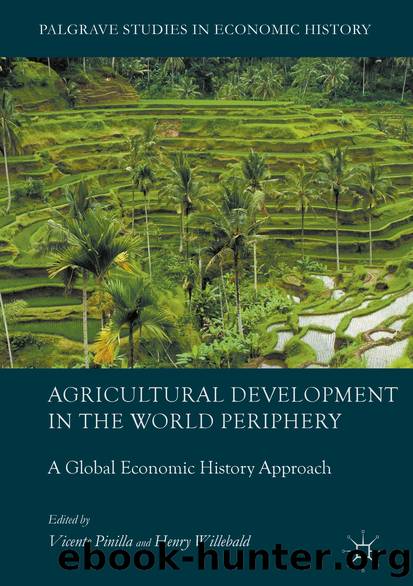Agricultural Development in the World Periphery by Vicente Pinilla & Henry Willebald

Author:Vicente Pinilla & Henry Willebald
Language: eng
Format: epub
Publisher: Springer International Publishing, Cham
Area
Output
Yields
(‘000 hectares)
(‘000 tons)
(tons/hectare)
Palm oil
Estates
5,654
19,343
3.42
Smallholders
3,908
10,990
2.81
Rubber
Estates
518
584
1.13
Smallholders
2,973
2,410
0.81
Source: Central Statistics Board, Statistical Yearbook of Indonesia, 2015, 234–237
It has already been argued that by the 1960s, several countries in Southeast Asia were dependent on rice imports, while in others (Burma and Vietnam ) the exportable surplus of rice had declined compared with the 1930s. There was growing anxiety about food, and especially rice , availability; in both Indonesia and the Philippines food imports were using up a considerable part of scarce foreign exchange. In the 1960s new higher yielding varieties of rice were developed at the International Rice Research Institute by crossing the dwarf variety grown in Japan with local Southeast Asian cultivars. Trials on test plots showed that in irrigated areas, with high application of fertiliser , much higher yields could be achieved. The challenge for governments across the region was to persuade millions of farmers to grow the new seeds, and also to use appropriate amounts of fertiliser . At first, many observers argued that farmers were too risk averse to use the new varieties, and that only the better off farmers would be able to afford fertiliser . The new technologies would thus lead to higher incomes for the richest farmers who cultivated irrigated land, while smaller farmers and farm labourers were unlikely to benefit. Overall it was argued that the “Green Revolution ” in rice agriculture would aggravate income disparities in rural areas, and would not greatly increase output.
In fact these arguments were too pessimistic. The new varieties were adopted by many millions of farmers across the region, including those cultivating small parcels of land. Fertiliser use did increase, especially in those countries (such as Indonesia ) where governments subsidised its farmgate price. If we compare rice yields in the main rice-growing countries of Asia in the 1960s with those achieved in the early twenty-first century, it is clear that many countries have seen at least a doubling of yields (Table 9.1). These figures refer to averages on all types of land; while it is broadly true that farmers cultivating well-irrigated land have achieved greater increases in yields, the evidence suggests that there have also been increases on rain-fed land. Yields growth has also occurred in corn , although less progress has occurred in rootcrops, which are still consumed quite widely among poorer groups.
The impact of the new rice technologies was probably most dramatic in Indonesia where production growth was rapid in the 1970s and 1980s, and the country moved from being the world’s largest rice importer in the 1970s to a rice exporter in the latter part of the 1980s. This achievement was hailed by the Suharto government, and also by many international experts.7 But by the end of the 1980s, critics were raising concerns about the resource costs of the Indonesian “rice miracle”. Domestic prices of rice were above world levels, and when Indonesia exported its surplus, world prices fell. Thus the Indonesian government was subsidising its farmers to grow rice , through the provision of cheap fertiliser and
Download
This site does not store any files on its server. We only index and link to content provided by other sites. Please contact the content providers to delete copyright contents if any and email us, we'll remove relevant links or contents immediately.
Pale Blue Dot by Carl Sagan(4613)
The Rules Do Not Apply by Ariel Levy(4523)
Goodbye Paradise(3446)
Ogilvy on Advertising by David Ogilvy(3327)
Delivering Happiness by Tony Hsieh(3280)
Liar's Poker by Michael Lewis(3221)
Into Thin Air by Jon Krakauer(3129)
Purple Cow by Seth Godin(3069)
Rogue Trader by Leeson Nick(2824)
The Social Psychology of Inequality by Unknown(2763)
The Airbnb Story by Leigh Gallagher(2700)
4 - Harry Potter and the Goblet of Fire by J.K. Rowling(2530)
The Mind Map Book by Tony Buzan(2415)
Bossypants by Tina Fey(2373)
All the President's Men by Carl Bernstein & Bob Woodward(2261)
Claridge's: The Cookbook by Nail Martyn & Erickson Meredith(2257)
Six Billion Shoppers by Porter Erisman(2225)
Master of the Game by Sidney Sheldon(2182)
Alibaba by Duncan Clark(1979)
